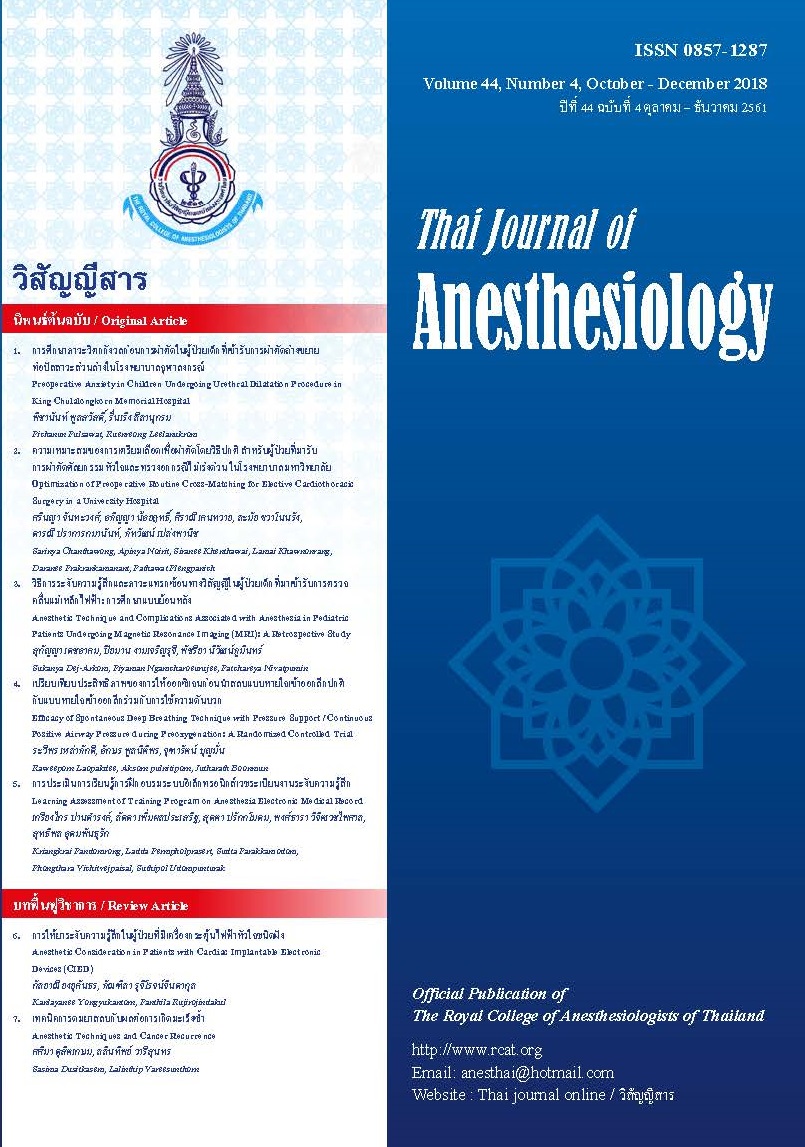Efficacy of Spontaneous Deep Breathing Technique with Pressure Support / Continuous Positive Airway Pressure during Preoxygenation: A Randomized Controlled Trial
Main Article Content
Abstract
Background: Preoxygenation with deep breathing technique for 1 minute is accepted for emergency situations. Pressure support (PS) and continuous positive airway pressure (CPAP) combined with tidal volume breathing for 3-5 minutes provides more rapidly increasing and achieved higher end-tidal oxygen (ETO2). The aim of this study was to determine the efficacy of deep breathing technique with PS/CPAP in term of ETO2.
Methods: Randomized controlled trial study was conducted in patients ASA I and II, aged 18-65 years old, undergoing elective surgery under general anesthesia. Control (C) group was preoxygenated by using deep breathing technique. Pressure (P) group used deep breathing technique combined with PS 4 cmH2O and CPAP 4 cmH2O. The ETO2 and respiratory discomfort scores were recorded at 1 minute.
Results: Forty-five patients were included for each group. The mean end-tidal oxygen (ETO2) at the end of 1 minute in P group and C group were 86.67 ± 3.91% and 83.98 ± 5.62% respectively. Mean difference between group was 2.69 ± 1.02 (95% CI 0.66-4.72, p = 0.01). Thirty-five patients (77.8%) in P group and twenty-one patients (46.7%) in C group got ETO2 ≥ 85% in 1 minute which were significantly different (p = 0.002). Respiratory discomfort scores were not significantly difference (p = 0.971) in both groups.
Conclusion: Application of PS and CPAP combined with deep breathing technique for one-minute preoxygenation provides higher ETO2.
Article Details
References
2. Benumof J. Preoxygenation: best method for both efficacy and efficiency? Anesthesiology 1999;91(3):603–5.
3. Nimmagadda U, Chiravuri SD, Salem MR, et al. Preoxygenation with tidal volume and deep breathing techniques: the impact of duration of breathing and fresh gas flow. Anesth Analg 2001; 92(5): 1337-41.
4. Tanoubi I. Oxygenation before anesthesia in adults. Anesthesiology Rounds 2006; 5(3): 1-6.
5. Baraka AS, Taha SK, Aouad MT, et al. Preoxygenation: comparison of maximal breathing and tidal volume breathing techniques. Anesthesiology 1999; 91(3): 612-6.
6. Tanoubi I, Drolet P, Donati F. Optimizing preoxygenation in adults. Can J Anesth 2009; 56(6): 449-66.
7. Bouroche G, BourgainJL. Preoxygenation and general anesthesia: a review. Minerva Anestesiol 2015; 81(8):910-20.
8. Tanoubi I, Droplet P, Fortier LP, Donati F. Inspiratory support versus spontaneous breathing during preoxygenation in healthy subjects. A randomized, double blind, cross-over trial. Ann Fr Anesth Reanim 2010; 29(3): 198-203.
9. Delay JM, Sebbane M, Jung B, et al. The effectiveness of noninvasive positive pressure ventilation to enhance preoxygenation in morbidly obese patients: a randomized controlled study. Anesth Analg 2008; 107(5):1707-13.
10. Harbut P, Gozdzik W, Stjernfält E, et al. Continuous positive airway pressure/pressure support pre-oxygenation of morbidly obese patients. Acta Anaesththesiol Scand 2014; 58(6): 675-80.
11. Sessumpun K, Pangvong W, Pulnitiporn A. Preoxygenation with oxygen-prefilled anesthesia breathing system increased end tidal oxygen within two minutes: a randomized controlled trial. Thai J Anesthesiol 2018; 44(2): 51-57.

